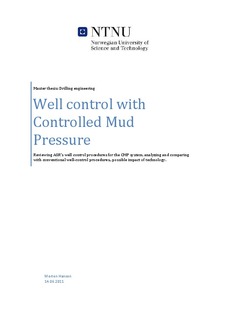| dc.contributor.author | Hansen, Morten | nb_NO |
| dc.date.accessioned | 2014-12-19T12:15:23Z | |
| dc.date.available | 2014-12-19T12:15:23Z | |
| dc.date.created | 2012-01-04 | nb_NO |
| dc.date.issued | 2011 | nb_NO |
| dc.identifier | 472705 | nb_NO |
| dc.identifier.uri | http://hdl.handle.net/11250/239548 | |
| dc.description.abstract | Dual Gradient Drilling (DGD) are a portfolio of drilling systems that in various ways pumpreturns from the well through a mud return line (MRL) from the seafloor, or somewhere between the seafloor and the rig floor. Two variations exist, with or without a marine riser.
The system without riser is an open system which is intended for tophole sections where a blowout preventer (BOP) is not used. When depths are reached that require a BOP, a subsea BOP can be applied together with a riser. Both systems results in the augmentation of the fluid column by adding a lighter fluid gradient on top of the outtake to the MRL and subsea pump. In the event of an open system, this will be the seawater, with riser different blanket fluids can be used, like seawater, nitrogen or just a lighter mud component like base oil.
The controlled mud pressure (CMP) system is offered by AGR and applies a MRL together with a subsea pump to take returns from the wellhead to the rig. This system uses a riser,and can thus drill deeper than tophole applications and is intended to handle well control situations. Together with systems such as @Balance’s dynamic annular pressure control (DAPC) system and Secure Drilling’s microflux control (MFC) it represents the future of automated kick detection, control and handling. The two latter are offered as parts or supplements to mainly managed pressure drilling (MPD) systems. One of them also aims to increase safety by automation to all drilling systems on any rig.
The CMP technology can be seen as enabling and improving for drilling deep water prospects, as well as through zones with either tight drilling windows or depleted pressures.The potential for automated well control can become a major increase in safety and improvethe way kicks are handled. There are some challenges still to overcome, mainly the development of the anti u-tube valve, or other options to solve problems related to u-tubing, as well as looking into the issue of gas boiling in the circulation system. | nb_NO |
| dc.language | eng | nb_NO |
| dc.publisher | Norges teknisk-naturvitenskapelige universitet, Fakultet for ingeniørvitenskap og teknologi, Institutt for petroleumsteknologi og anvendt geofysikk | nb_NO |
| dc.title | Well control with Controlled Mud Pressure: Reviewing AGR’s well control procedures for the CMP system, analyzing and comparing with conventional well-control procedures, possible impact of technology. | nb_NO |
| dc.title.alternative | Brønnkontroll med AGRs dualgradient system | nb_NO |
| dc.type | Master thesis | nb_NO |
| dc.contributor.department | Norges teknisk-naturvitenskapelige universitet, Fakultet for ingeniørvitenskap og teknologi, Institutt for petroleumsteknologi og anvendt geofysikk | nb_NO |
